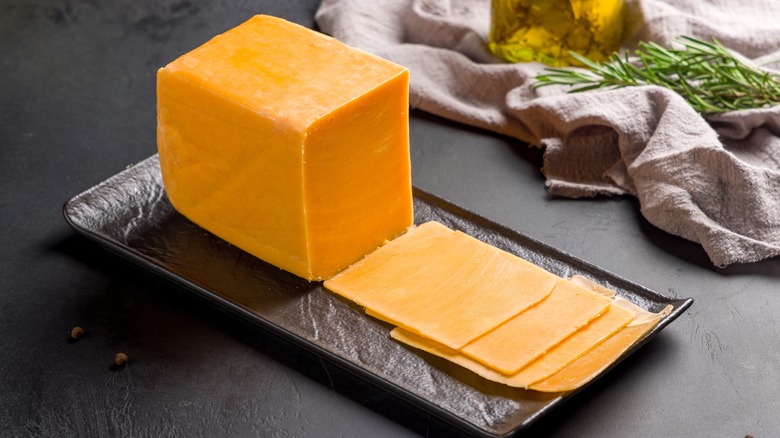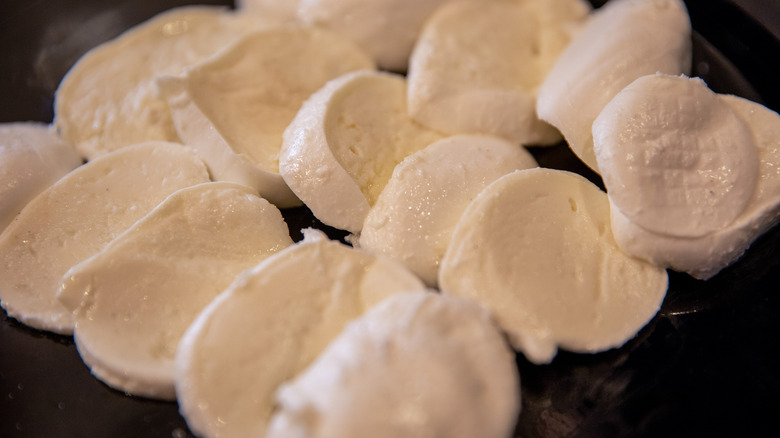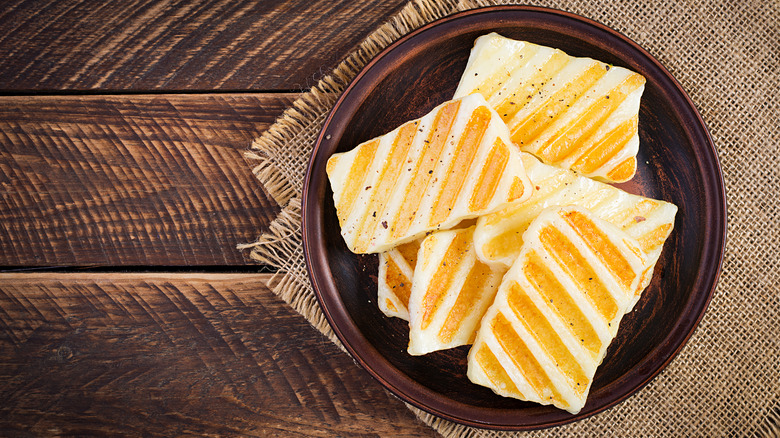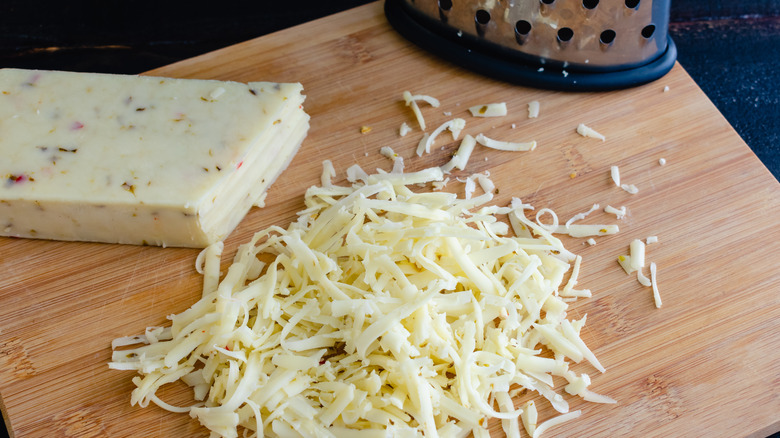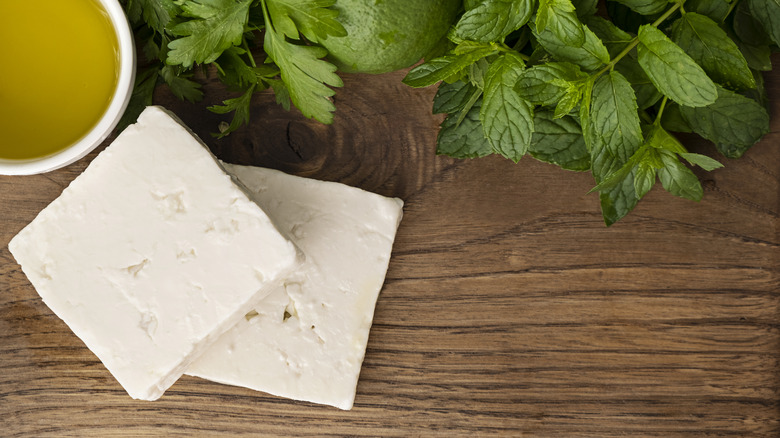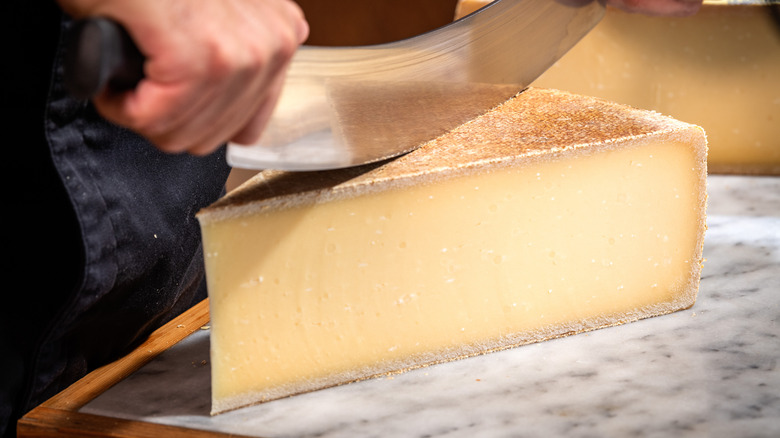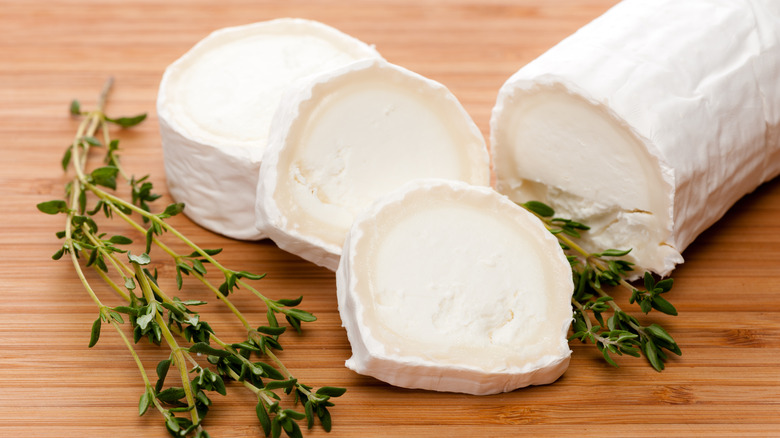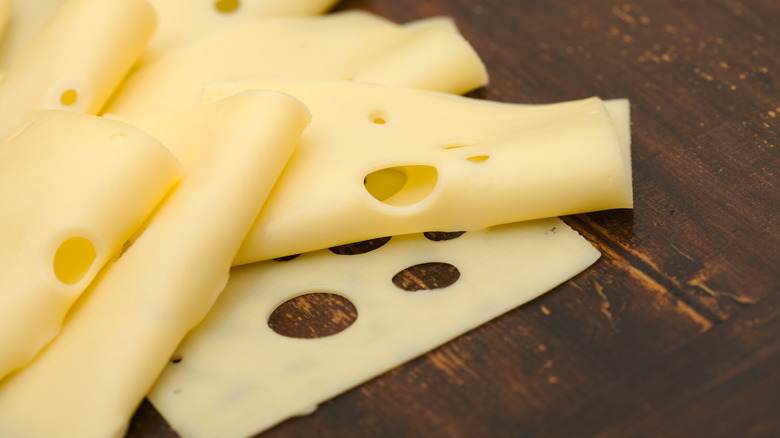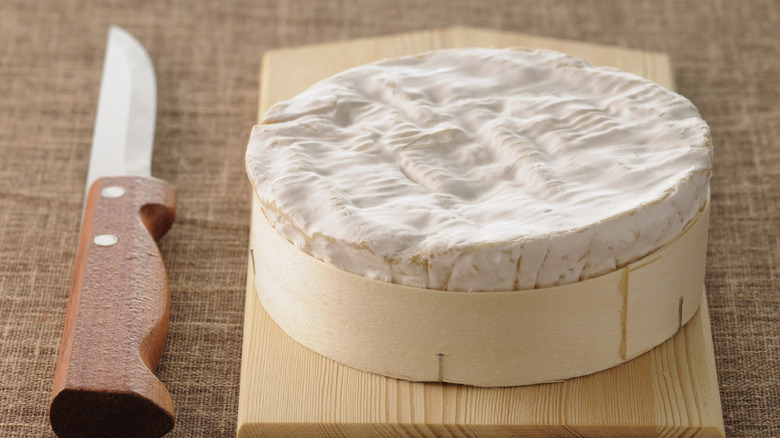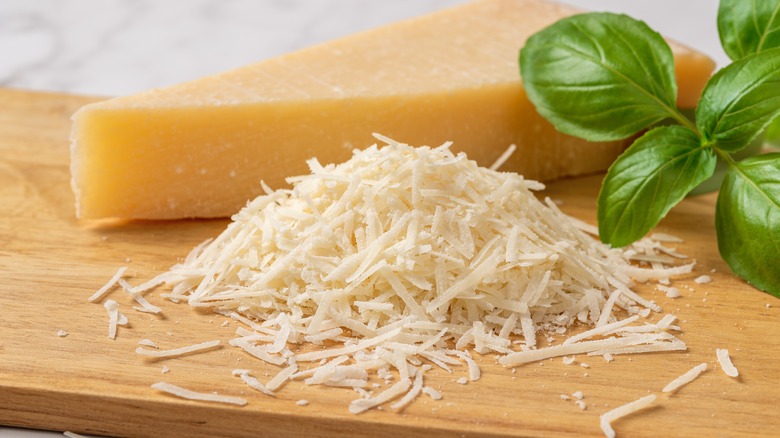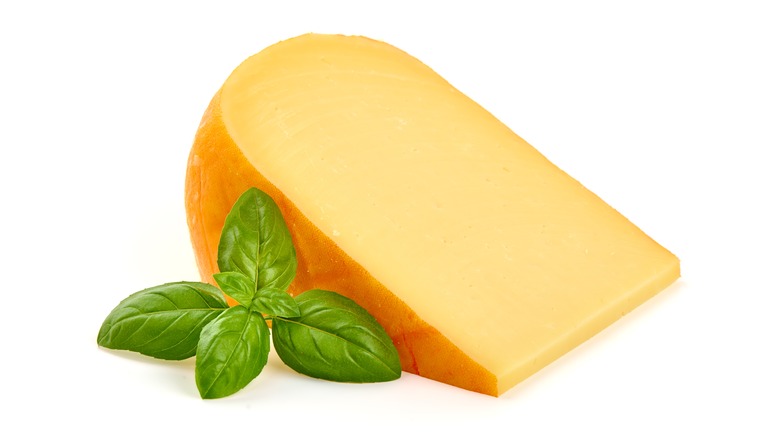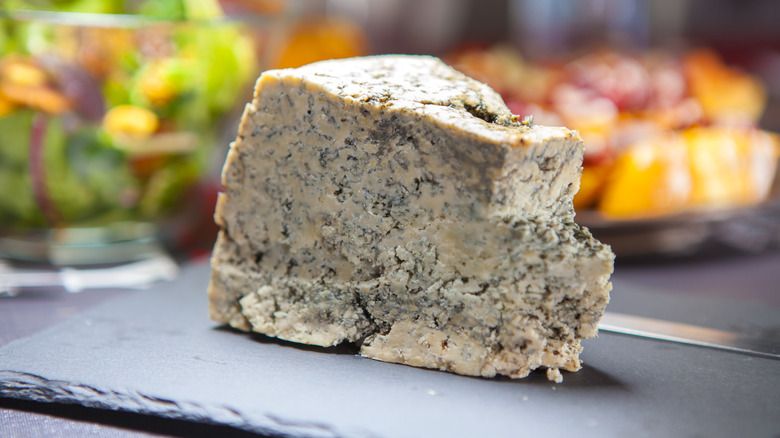The 7 Best And 7 Worst Types Of Cheese To Put On A Fish Sandwich
It's hard to beat a good fish sandwich. Sandwiches containing fish come in many different shapes and forms, from the humble tuna with mayo to the timeless smoked salmon and cream cheese bagel. When many of us think of a fish sandwich, though, we think of a generous chunk of crispy deep-fried fish sitting between two slices of thick white bread. While the exact origins of fried fish sandwiches remain unclear, they were arguably made way more mainstream by the McDonald's Filet-O-Fish, which made its first appearance in 1962 and has been a mainstay on the chain's menu ever since.
The Filet-O-Fish is, in a sense, the archetypal fish sandwich, and the inclusion of cheese makes all the difference. In both the Filet-O-Fish and in homemade fish sandwiches, the cheese serves as a counterpoint to the crispiness of the batter and fills the sandwich with savory, creamy flavors that the fish doesn't necessarily provide. There are as many types of cheese as there are types of fish, though — and not all of them will work in a fish sandwich. Some cheese has the right blend of texture and taste that makes it the ideal addition, whereas others tend to be too crumbly, hard, or chewy. We're here to separate the best from the worst.
Best: Cheddar
For a good old-fashioned fish sandwich, you really can't go wrong with cheddar. Cheddar cheese is a classic choice for fried fish sandwiches, thanks to its ability to boost flavor without making your sandwich too complicated. Cheddar has an accessible savoriness and a saltiness that offsets the fried fish and pairs well with any sauces you want to add in, like tartare or ketchup. It also melts easily and turns gooey, soft, and stretchy when warm, which also helps to keep the sandwich locked together. To top it all off, it's also one of the most widely available cheeses out there, and you can easily pick up a good block with your groceries.
You can use virtually any type of cheddar you like in a fish sandwich, but a mild or medium style will usually be the best bet. You can also use an aged cheddar if you wish, which will give your sandwich more sharpness and slightly more complex flavor — although it's arguable that these styles should be kept for your crackers, to allow their notes to shine through fully. You can use either white or yellow cheddar, but we would recommend the latter, to give your fish sandwich maximum visual impact.
Worst: American
Okay, so we know this is going to be controversial, but hear us out. American cheese is the standard slice of choice for many in a fish sandwich, no doubt thanks to the Filet-O-Fish popularizing its use around the world. However, we would argue that there are so many other types of cheese that can elevate your sandwich even better than American — especially when you consider the fact that American cheese isn't cheese at all.
This foodstuff is classed as a "cheese product," because it contains a lower amount of cheese curds and is chock full of additives and preservatives. Instead of getting its flavor through an aging process and quality ingredients, it gets it through a sky-high sodium content, with 468 milligrams per slice. This sodium content is almost 20% of your daily value, a huge amount for such a small piece of food.
In addition, its salt levels, extra ingredients, and production process all lead to it having a bland, artificial, slightly plasticky flavor that will distract from your fish instead of augment it. It may melt well, sure, but there are so many other types of cheese out there that will melt just as well and make your sandwich taste better, instead of worse.
Best: Mozzarella
Looking for a premium cheese pull in your sandwich? Look no further than mozzarella. This classic cheese excels in fish sandwiches thanks to its pliability and gooeyness, which it gains thanks to its higher moisture content helping to soften it. This stretchiness gives more than just a visual pop when you take a bite of your fish sub — it also creates an exciting mouthfeel, especially when balanced against the crispy, fatty piece of fish.
Mozzarella also brings a nice creaminess to fish sandwiches and is especially good with stronger-tasting beer batters or saltier coatings. As mozzarella's flavor is quite mild, though, you might want to contrast it with a stronger component to bring out its gentle dairy flavors. Try using it in a sandwich spread with tomato sauce to make a mozzarella stick effect for your meal, or throw a few squirts of hot sauce onto your fish to bring a little spice to the proceedings. If you're using good-quality mozzarella, though, you likely won't need to resort to too much trickery to bring out its flavor, and you also won't want to distract from it too much.
Worst: Halloumi
There's a time and a place for halloumi, but unfortunately, it isn't in a fish sandwich. Halloumi is one of the most robust cheeses out there and resists softening fully when heated, thanks to its high melting point. This is thanks to the cheese's high pH level, which helps it retain its shape while crisping up nicely on its outside.
This makes halloumi the perfect cheese for grilling or frying on its own, but when it's put into a fish sandwich, the fact that it doesn't melt becomes a problem. Instead of draping itself lusciously over the fish, it sits like a chewy, squeaky brick on top. When you then bite into your fish sandwich, you'll likely find that everything's just way too much of a mouthful, and your sandwich becomes difficult to eat.
We would instead recommend using halloumi cheese as a total replacement for fish, in a vegetarian fish sandwich. Batter a thick chunk of halloumi and then deep-fry it, just as you would a fish fillet. The gentle, salty flavor of the cheese makes a perfect replacement for your fish, and it goes just as well with the classic spreads or sauces that you might put on your regular sandwich.
Best: Pepper Jack
Using Pepper Jack in your fish sandwich gives you the perfect balance of spice and creaminess. Pepper Jack is a variant of Monterey Jack and is full of flavor thanks to the addition of spices, herbs, chiles, and garlic. All of these seasonings give the cheese a hugely complex, dynamic flavor that brightens up fried fish fillets hugely, while the creamy notes underneath temper them, stopping the spicy elements from becoming too overpowering.
As well as this, Pepper Jack is also an excellent melting cheese and softens super quickly due to its higher water content. When selecting your Pepper Jack, keep in mind that brands and varieties can differ pretty significantly in terms of their spice levels — while some may be fairly mild, others may be way more fiery than you anticipated. You'll always want to do a taste test, therefore, to make sure that your Pepper Jack isn't too hot for your fish sandwich. If it is, remember that you can always mix it with other, milder cheeses, like Gouda or mozzarella, to bring its overall heat levels down.
Worst: Feta
Feta is good for a lot of things — stuffing between slices of filo pastry, chunking into a fresh watermelon salad, or crumbling onto a bowl of hot soup as a topper — but it's not good for fish sandwiches. In feta's case, its low pH level (which hovers at around 4.7) means that it doesn't melt very effectively. (Cheeses with a pH between 5 and 5.5 melt best.) While feta does soften somewhat when heated up, it doesn't end up as the stretchy, gooey mass that cheeses like mozzarella or cheddar do, and this makes it a pretty unsatisfying choice for topping your fried fish.
Some folks may also find feta's flavor to be a little distracting in a fish sandwich. Feta can vary in its sharpness, but certain types can be incredibly strong and briny, providing sharpness where you ideally want a mellow, savory smoothness. That's not to say that feta never works with fish, but you should save it for recipes where its acidity is welcome. Feta-stuffed salmon with cherry tomatoes, for example, contrasts the savory depths of salmon and the slight fruitiness of tomatoes with the sharp tang of feta, with its solidity giving the fish extra bite.
Best: Gruyere
When you need a little melt, Gruyere is one of the most popular cheeses out there. This Alpine cheese is often used in fondue, thanks to its ability to turn ultra-smooth and creamy when heated up, and it's often used in mixtures for mac and cheese. This textural quality makes it a natural fit for fish sandwiches, which require a cheese that's able to melt easily but still provides enough flavor to hold its own against the salty, fatty batter.
Luckily, Gruyere delivers on the flavor front, too. This cheese has a light nuttiness that sets it apart from similar styles, and this ever-so-slight bitterness pairs with its butteriness and adds a new flavor dimension to your sandwich. Its salty notes help to tie all of these flavors together, lifting the taste of the cheese as well as your fish. Remember that Gruyere can have a fairly strong smell when it's unwrapped, due to its production process — but rest assured that this smell doesn't necessarily translate into a super-strong taste. This smell usually comes from its rind, which is cut off before the cheese is eaten.
Worst: Goat cheese
Goat cheese is an acquired taste for some, and its pungent flavor and smell can mean that it's pretty overpowering in some recipes. The quality that makes people fall in love with goat cheese — namely its "goatyness," a strong, tangy, somewhat musty flavor — is also what tends to turn some people off it. This flavor tends to be at its strongest when the cheese is made with slightly older milk, and interestingly, a more intense goatyness can indicate a poorly made product sometimes.
When used right, this distinctive flavor can be pure heaven; unfortunately, it doesn't tend to meld well with fish. The intense flavor tends to be way too distracting in a fish sandwich, making the cheese the only thing you can taste and pulling you away from the flavor of the fish itself. If that wasn't enough, it's worth remembering that goat cheese doesn't melt like other types of cheese and instead develops a creamier texture when hot. We think goat cheese should be reserved for situations where its distinctive flavor is allowed to shine. Marinated goat cheese, for example, is a great way to bulk up its natural taste with additional elements, while still letting its goatyness stand front and center.
Best: Swiss
There's a good reason why Swiss cheese is such a commonly used cheese in sandwiches: It tastes pretty darn good, and it melts pretty darn well. Swiss cheese has the perfect balance of meltiness and a subtle yet individual taste that makes it a top choice for a fish sandwich. Like Gruyere, it has a gentle flavor and a light nuttiness to it, although Swiss cheese's nuttiness tends to be underpinned by a little more creaminess, which pairs perfectly with your pub-worthy fried fish batter. As Swiss cheese's flavor doesn't vary too much from brand to brand, you also don't have to put too much thought into purchasing it, making it a reliable choice (especially when you're hungry and can't think straight).
Additionally, Swiss cheese isn't just a great choice for fried fish buns — it also works with other sandwiches based around fish. It's the perfect cheese for a tuna melt, pairing with the briny taste of the tuna well and tempering its intensity somewhat. It'd be just as good mixed into a fish gratin, too, with some extra Swiss on top to finish things off.
Worst: Camembert
If you want to finish off a dinner party in style, busting out a block of Camembert is the way to do it. However, while this French cheese may pair well with crackers and grapes, it's slightly less successful in a fish sandwich. Camembert's ripening process can produce a pretty intense, complex flavor and strong smell, which can become fairly distracting when paired with fried fish. Although you can find young Camemberts that are pretty mild, they still have a layered taste that just doesn't suit the flavor profile of a fish sandwich well.
The main reason you should avoid Camembert, though, is because of its texture. Like Brie, Camembert is a mix of a hard, chalky rind and a gooey interior cheese. While you can of course cut the rind away, the cheese itself tends to become oozy and near-uncontrollable when soft, as well as having a slightly gummy mouthfeel that doesn't work well with the flaky fish. You should instead enjoy your Camembert on its own wherever possible (or, as mentioned, with some choice accompaniments) so that you can enjoy its distinctive taste and texture and not have it be a hindrance in your fried fish sub.
Best: Parmesan
Parmesan can provide flavor like few other cheeses can. Although a lot of cheeses carry savory notes, parmesan takes things to the next level, with its high proportion of glutamates giving it an umami-fied intensity. It's this umami that comes into play in a fish sandwich. Even a light sprinkling of parmesan will give a fish sandwich savory depth and help to add complexity to what can be a pretty basic sandwich. It also pairs brilliantly with other, milder cheeses like mozzarella, which can give your food even deeper dimensions of taste.
Bear in mind, though, that you'll likely want to use parmesan pretty sparingly, as too much will make it the primary flavor in your sandwich. It's also useful to use parmesan lightly since it doesn't tend to melt as well as other cheeses, so it's better as a garnish on more meltable options like cheddar, Swiss, or mozzarella. Although parmesan can bring a new lease of life to a fried fish sandwich, that's not the only style of fish sandwich it's good for. Tuna melts can be given an extra pop of flavor by parmesan, with a dusting of shredded parm over the standard cheddar deepening their savory tones.
Worst: Cream cheese
For a fried fish sandwich, cream cheese is not your best friend. The deep creaminess of the cheese can work well on a flavor level and serve as a counterpoint to the saltiness of the batter. However, on a texture level, cream cheese is usually just way too dense to be pleasant, especially when it's slathered on thickly. This can leave your delicate fish fillet fighting with its creaminess, and usually losing out.
There's also the melting point of cream cheese to consider. Cream cheese melts at a pretty low temperature, and when it's heated, it tends to turn runny. When presented with the heat from your fried fish fillet, then, it can soften too much and soak into the batter, making everything gloopy and wet.
That's not to say that you should never use cream cheese with fish, or indeed in a fish sandwich. A cream cheese and salmon bagel, for example, is the stuff of heaven, with the sharp salmon contrasting excellently with the dairy-rich cheese flavors. In hot applications, however, the cheese just doesn't work.
Best: Gouda
To pack your fish sandwich with some extra complexity, pick Gouda. This Dutch cheese has a lot going on in each bite, and luckily, it all adds to the flavor of fried fish instead of distracting from it. Gouda has a nutty edge to its flavor which is underlined by slightly caramelized notes, and which are both brought together by its creaminess. It also has a gentle yet distinct scent which mirrors its flavor profile, and which gives your fried fish extra appeal.
Despite this, its overall effect remains pretty mild, and although it'll fill out your sandwich's flavor, it won't get in the way of the main event of the fish. Gouda also melts very well, which is partly why it's so popular in cheese-based recipes. Remember that there are different kinds of Gouda, with aged varieties being more intensely flavored and complicated, making them potentially unsuitable for a fish sandwich. Aged Gouda is also not as effective as melting, and it's best enjoyed on its own so that you can savor the work that's gone into its production.
Gouda also comes in a fairly common smoked variety. Although it's pretty incredible in a smoked Gouda macaroni and cheese, it may be a little too intense for your sandwich and become the main event in the meal, so you should probably opt for the unsmoked variety instead.
Worst: Blue cheese
While we admire the ambition behind putting blue cheese in a fish sandwich, we don't think you'll love the result. As anyone who's tried blue cheese will know, it has an incredibly powerful flavor that becomes the central aspect of virtually any food it's added to. Blue cheese's flavor is so powerful because of the mold that grows in and around it when it's aged, a strain of Penicillium that gives the cheese its powerful, musty notes. Although these flavors can work well in certain combos, they're less effective with fried fish, where they tend to overwhelm and make everything taste too briny.
Blue cheese is also a bit of a nightmare when it's melted. Rather than turn stretchy and gloriously gooey, it can become too watery and moisten your sandwich and the fish batter too much. If you are hankering for some blue cheese with your fish sandwich, we would recommend whipping up an easy blue cheese dressing that you can serve alongside it. You can then dip your sandwich in to your heart's content, without having to worry about it melting everywhere — and because blue cheese dressing contains mayonnaise and sour cream, the intensity of the cheese is tempered.

